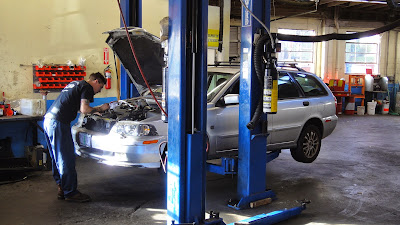We found this article over at esurance and thought we should
share it with you. A link to the original article is at the end.
Fall means a number of wonderful things, like warm, comfy
sweaters, foliage, and baking pumpkin pies. For drivers, fall also brings
unique dangers to the roads. Find out what makes fall driving dangerous and
what you can do to keep yourself safe.
Why driving in the fall can be dangerous...
Weather conditions can be unpredictable in the fall. A
bright, beautiful afternoon can turn rainy and cold in minutes. And with days
getting shorter, you could find yourself commuting to or from work in darkness.
Back-to-school
traffic
Fall means back to school for kids, which means more cars
and buses on the roads. Drivers also need to watch out for increased pedestrian
traffic in the morning and afternoon as children walk to and from school and
their neighborhood bus stops.
Rain
The first rain in a few weeks can be particularly dangerous,
as water pools on top of dust and oil that haven't had a chance to wash away
and makes the pavement extremely slippery.
Leaves (and leaf
peepers)
Fall foliage is certainly beautiful, but as leaves begin to
fall, they litter the roads, making streets slick while obscuring traffic lines
and other pavement markings. They also hide potholes and other road hazards.
And when it rains, it can make those wet leaves on the roadway as dangerous as
ice.
And where there are turning leaves, there are leaf peepers.
These leaf-peeping drivers tend to crawl along the roads and make unpredictable
stops to admire the changing foliage. If you're driving behind a car with
out-of-state plates, give them a little extra space just in case they stop
short for a photo.
Fog
Cold fall mornings often lead to fog, which can greatly
limit your driving visibility and perception of distance. Fog tends to occur in
low places or areas surrounded by hills, water, mountains, and trees. One
common mistake drivers make during foggy conditions is putting on their high
beams instead of staying with their low beams. This only makes visibility worse
because your high beams will bounce off the fog and create glare.
When driving through fog, slow down and stay well behind the
car in front of you so you'll have adequate time to stop if you need to.
Frost
During the fall, temperatures tend to drop dramatically
during the night, which can lead to morning frost and icy spots on the road.
This is especially common on bridges, overpasses, and shaded areas of the road.
Sun glare
Fall is also a bad time for sun glare on the roads. Sun
glare can impact your sight for seconds after exposure, making it hard to see
pedestrians, oncoming traffic, or the car in front of you. According to the
National Highway Traffic Safety Administration, drivers describe being
"blinded" after exposure, and this sometimes leads to accidents or
near misses.
Sun glare can also cause problems when the sun sets behind
drivers. In this case, sunlight can bounce off your rearview mirror or reflect
off traffic lights up ahead, and this can blind you for a split second while
your eyes adjust. It can also make it hard (or impossible) to see traffic
lights, which can prevent you from knowing if you're supposed to stop or go.
Deer
The fall season brings an increase in deer activity because
it's their time for mating and migrating. If you live in a deer-heavy area,
watch for darting deer, especially when driving at night.
Fall driving tips
- Being prepared for fall's inclement weather and hazardous driving challenges is half the battle.
- Watch your speed: Drive a bit slower when faced with fall driving hazards, especially if you're driving around a school bus.
- Keep your distance: Leave a little more space between you and the car in front on rainy or foggy days, during dawn or dusk, and in areas with wet leaves. This will give you more time to react.
- Stick with low beams: Keep your headlights on low when driving in the fog (and rain). High beams will only cause glare.
- Clear frost away from your windows: Frost can reduce visibility and response time on the road.
- Approach traffic lights carefully: Sun glare can make it harder to see traffic lights change, so approach them with more than the normal care.
- Avoid using products that increase gloss: Washing and waxing with these products can magnify the fall's sunny glare and make it hard to see.
- Clean your windshield, inside and out: When your windshield's illuminated by sunlight, dust particles, streaks, and smudges become magnified, making it hard to see the road.
- Watch for wildlife: especially in the early morning and evening hours.
- Check your tire pressure: Since fall weather rapidly changes from warm to cold, your tires will often expand and contract. This can lead to a loss of pressure.
Driving safely in the
fall
Knowing what to look for and using these tips can help you
avoid weather-related car accidents in the fall. For more seasonal driving
tips, visit the pages below.
You can read the original article here: https://www.esurance.com/info/car/dangers-of-fall-driving
Please take extra care while driving this fall. Call
Broadway Imports at 503.282.0817 to schedule an oil change, tune-up, or whatever
else your car needs. Please contact us for
any auto service or repair you might have. Schedule an appointment today!
#dangersoffalldriving
#falldriving
#falldrivingtips
#broadwayimports
#broadwayimportautoservice
#falldriving
#falldrivingtips
#broadwayimports
#broadwayimportautoservice






No comments:
Post a Comment